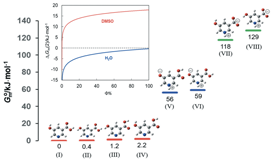
Tautomer Selection Through Solvate Formation: the Case of 5-Hydroxynicotinic Acid
A. Joseph, J.S.R. Alves, C.E.S. Bernardes, M.F.M. Piedade, M.E. Minas da Piedade
CrystEngComm 2019, 21, 2220-2233.
Abstract
The importance of controlling the crystallization of molecules in specific conformations for the production of crystalline organic materials with highly reproducible physicochemical properties has long been recognized. Using 5-hydroxynicotinic acid (5HNA) as a model the following two questions were addressed in this work: (i) is it possible to promote the crystallization of a tautomeric form dominant in a specific solvent through solvate formation? (ii) Does that form persist if the memory of solvation is erased through thermal desolvation? Single crystal X-ray diffraction (SCXRD) analysis indicated that the crystallization of 5HNA from water and dimethyl sulfoxide do indeed lead to a monohydrate, 5HNA·H2O, and a monosolvate, 5HNA·DMSO, respectively, where the tautomeric form preferred in solution is preserved (zwitterionic in H2O and neutral in DMSO). Subsequent differential scanning calorimetry (DSC), thermogravimetry (TG), powder X-ray diffraction (PXRD), and diffuse reflectance infrared Fourier transform (DRIFT) spectroscopy studies indicated that: (i) albeit upon thermal desolvation different solid forms are initially produced, their structures converge over time to that of the 5HNA starting material, hence to a crystal lattice consisting of the same tautomer; (ii) this tautomer corresponds to a zwitterion. The hydrate and solvate forms showed very distinct solvent loss behaviors at 298 K: 5HNA·H2O did not undergo dehydration even when kept under a reduced pressure, while 5HNA·DMSO was only stable for long periods of time if stored in a closed vial. A thermodynamic analysis based on DSC and Calvet drop microcalorimetry results allowed to rationalize these observations indicating that: (i) 5HNA·H2O is predicted to spontaneously lose water, even for a relative humidity of 100%, hence its robustness is most certainly of kinetical origin; (ii) 5HNA·DMSO is thermodynamically stable when a saturation DMSO pressure can be established over the sample, but becomes unstable when exposed to an atmosphere where the solvent is absent. The kinetically easier desolvation of 5HNA·DMSO compared to 5HNA·H2O may be related to the fact that water is isolated in the crystal lattice (isolated site hydrate) while DMSO is placed in channels (channel solvate).
Return Previous Next